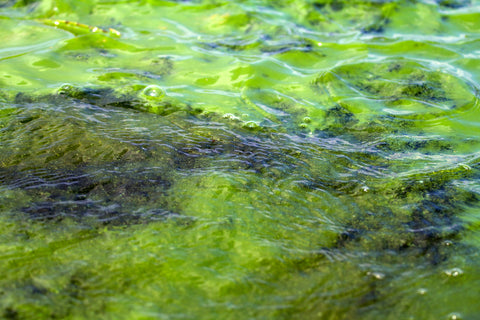Algae Overgrowth: A Cautionary Tale

Algae plays a crucial role in our ecosystems. Learn more in our blog, "10 Fascinating Facts About Algae You Might Not Know". However, while algae is fascinating, too much of a good thing can be bad.
When algae begin to overrun ponds, it can lead to detrimental consequences.
Deplete Oxygen Levels
Excessive algae growth, often referred to as algae blooms, can deplete oxygen levels in the water, endangering fish and other aquatic life.

Release of Toxins
Also, certain types of algae can release toxins, posing a threat to both the ecosystem and potential users of the water.
Blue-Green Algae
And we have likely all heard about the harmful blue-green algae. "Exposure to any blue-green algae blooms can cause health effects in people and animals when water with blooms is touched, swallowed, or when airborne droplets are inhaled. Exposure to high levels of blue-green algae and their toxins can cause diarrhea, nausea or vomiting; skin, eye or throat irritation; and allergic reactions or breathing difficulties." (Source: News York State, Department of Health, Harmful Blue-Green Algae: Frequently Asked Questions)

Dealing with Algae Overgrowth:
1. Aeration
Introducing aeration systems can help maintain oxygen levels and disrupt the conditions favorable for algae blooms.
2. Nutrient Control
Reduce nutrient inputs by managing fertilizers and preventing runoff from lawns and surrounding areas. This helps curb the excessive nutrient supply that fuels algae growth.
3. Manual Removal
If algae overgrowth is severe, manual removal using nets or other tools can be employed. However, this is often a temporary solution and may need to be complemented by other management strategies.
4. Shade
Planting vegetation around the pond or using floating plants can provide shade, limiting sunlight penetration and slowing down algae growth.
5. Beneficial Bacteria
Introduce beneficial bacteria to the pond. These bacteria can break down organic matter, reducing nutrient levels and inhibiting algae proliferation.
Earth Smart Solutions offers a product called, Pond Prevention (ESAA), which is effective at managing algae in ponds by introducing beneficial bacteria.
Following are a few before and after photos which were submitted by clients who have used ESAA to treat their algae.

ESAA works by breaking down excess debris in your pond such as animal and plant waste, sludge, and runoff from the surrounding land. It uses a natural combination of enzymes, extracts, and beneficial bacterial that are proven to leave your pond looking clean and clear. It is water activated and effective conditioning is most easily achieved when algae are not yet well established. Learn more about this product here.

Remember, maintaining a balanced ecosystem is key to preventing and managing algae overgrowth in ponds. Regular monitoring and proactive measures are essential for preserving the health and beauty of these aquatic environments.




Leave a comment